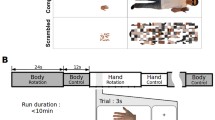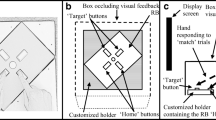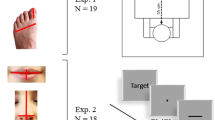Abstract
Analogously to the visual system, somatosensory processing may be segregated into two streams, with the body constituting either part of the action system or a perceptual object. Experimental studies with participants free from neurological disease which test this hypothesis are rare, however. The present study explored the contributions of the two putative streams to a task that requires participants to estimate the spatial properties of their own body. Two manipulations from the visuospatial literature were included. First, participants were required to point either backward towards pre-defined landmarks on their own body (egocentric reference frame) or to a forward projection of their own body (allocentric representation). Second, a manipulation of movement mode was included, requiring participants to perform pointing movements either immediately, or after a fixed delay, following instruction. Results show that accessing an allocentric representation of one’s own body results in performance changes. Specifically, the spatial bias shown to exist for body space when pointing backward at one’s own body disappears when participants are requested to mentally project their body to a pre-defined location in front space. Conversely, delayed execution of pointing movements does not result in performance changes. Altogether, these findings provide support for a constrained dual stream hypothesis of somatosensory processing and are the first to show similarities in the processing of body space and peripersonal space.





Similar content being viewed by others
References
Anema HA, van Zandvoort MJE, De Haan EHF, Kappelle LJ, de Kort PLM, Jansen BPW, Dijkerman HC (2009) A double dissociation between somatosensory processing for perception and action. Neuropsychologia 47:1615–1620
Atkeson CG, Hollerbach JM (1985) Kinematic features of unrestrained vertical arm movements. J Neurosci 5:2318–2330
Bagesteiro LB, Sainburg RL (2002) Handedness: dominant arm advantages in control of limb dynamics. J Neurophysiol 88:2408–2421
Bisiach E, McIntosh RD, Dijkerman HC, McClements KI, Colombo M, Milner AD (2004) Visual and tactile length matching in spatial neglect. Cortex 40:651–657
Blanke O, Landis T, Spinelli L, Seeck M (2004) Out-of-body experience and autoscopy of neurological origin. Brain 127:243–258
Blanke O, Mohr C, Michel CM et al (2005) Linking out-of-body experience and self processing to mental own-body imagery at the temporoparietal junction. J Neurosci 25:550–557
Bottini G, Bisiach E, Sterzi R, Vallar G (2002) Feeling touches in someone else’s hand. Neuroreport 13:249–252
Carson RG, Elliott D, Goodman D, Chua R (1993) Asymmetries in the regulation of visually guided aiming. J Motor Behav 25:21–32
Christman SD, Bentle M, Niebauer CL (2007) Handedness differences in body image distortion and eating disorder symptomatology. Int J Eat Disord 40:247–256
Cohen NR, Cross ES, Tunik E, Grafton ST, Culham JC (2009) Ventral and dorsal stream contributions to the online control of immediate and delayed grasping: a TMS approach. Neuropsychologia 47:1553–1562
Committeri G, Pitzalis S, Galati G et al (2007) Neural bases of personal and extrapersonal neglect in humans. Brain 130:431–441
De Vignemont F, Tsakiris M, Haggard P (2005) Body mereology. In: Knoblich G, Thornton IM, Grosjean M, Shiffrar M (eds) Human body perception from the inside out. Oxford University Press, New York, pp 147–170
Desmurget M, Prablanc C, Jordan M, Jeannerod M (1999) Are reaching movements planned to be straight and invariant in the extrinsic space? Kinematic comparisons between compliant and unconstrained motions. Q J Exp Psychol 52 A:981–1020
Desmurget M, Gaveau V, Vindras P, Turner RS, Broussolle E, Thobois S (2004) On-line motor control in patients with Parkinson’s disease. Brain 127:1755–1773
Dijkerman HC, De Haan EHF (2007) Somatosensory processes subserving perception and action. Behav Brain Sci 30:189–239
Ehrsson HH, Spence C, Passingham RE (2004) That’s my hand! Activity in premotor cortex reflects feeling of ownership of a limb. Science 305:875–877
Elliott D, Chua R, Pollock BJ (1994) The influence of intermittent vision on manual aiming. Acta Psychol 85:1–13
Goble DJ, Brown SH (2008a) The biological and behavioral basis of upper limb asymmetries in sensorimotor performance. Neurosci Biobehav Rev 32:598–610
Goble DJ, Brown SH (2008b) Upper limb asymmetries in the matching of proprioceptive versus visual targets. J Neurophysiol 99:3063–3074
Goble DJ, Brown RJ (2009) Dynamic proprioceptive target matching behavior in the upper limb: effects of speed, task difficulty and arm/hemisphere asymmetries. Behav Brain Res 200:7–14
Gurfinkel VS, Levick YS (1991) Perceptual and automatic aspects of the postural body scheme. In: Paillard J (ed) Brain and space. Oxford University Press, Oxford, pp 147–162
Hach S, Schütz-Bosbach S (2010) Sinistrals’ upper hand: evidence for handedness differences in the representation of body space. Brain Cognit 72:408–418
Halligan PW, Hunt M, Marshall JC, Wade DT (1995) Sensory detection without localization. Neurocase 1:259–266
Ishihara M, Imanaka K (2008) Visual perception and motor preparation of manual aiming: a review of behavioral studies and neural correlates. In: Nilsson IL, Lindberg WV (eds) Visual perception: new research. Nova Publishers, Inc, USA, pp 1–48
Jewell G, McCourt ME (2000) Pseudoneglect: a review and meta-analysis of performance factors in line bisection tasks. Neuropsychologia 38:93–110
Kammers MPM, van der Ham IJM, Dijkerman HC (2006) Dissociating body representations in healthy individuals: differential effects of kinaesthetic illusion depending on body representations. Neuropsychologia 44:2430–2436
Kammers MPM, De Vignemont F, Verhagen L, Dijkerman HC (2009) The rubber hand illusion in action. Neuropsychologia 47:204–211
Kappers AML (2007) Haptic space processing—Allocentric and egocentric reference frames. Can J Exp Psychol 61:208–218
Ketelaars MAC, Garry MI, Franks IM (1997) On-line programming of simple movement sequences. Human Mov Sci 16:461–483
Linkenauger SA, Witt JK, Bakdash JZ, Stefanucci JK, Proffitt DR (2009) Asymmetrical body perception: a possible role for neural body representations. Psychological Science 20:1373–1380
Longo MR, Haggard P (2010) An implicit body representation underlying human position sense. Proc Nat Acad Sci 107:11727–11732
Longo MR, Azanon E, Haggard P (2010) More than skin deep: body representation beyond primary somatosensory cortex. Neuropsychologia 48:655–668
Marcel AJ (2003) The sense of agency: awareness and ownership of action. In: Roessler J, Eilan N (eds) Agency and self-awareness. Oxford University Press, Oxford
Marsh EB, Hillis AE (2008) Dissociation between egocentric and allocentric visuospatial and tactile neglect in acute stroke. Cortex 44:1215–1220
Milner AD, Goodale MA (1993) Visual pathways to perception and action. Prog Brain Res 95:317–337
Milner AD, Goodale MA (2008) Two visual systems re-viewed. Neuropsychologia 46:774–785
Niebauer CL, Aselage J, Schutte C (2002) Hemispheric interaction and consciousness: degree of handedness predicts the intensity of a sensory illusion. Laterality 7:85–96
Ocklenburg S, Rüther N, Petersburs J, Pinnow M, Güntürkün O (2010) Laterality in the rubber hand illusion. Laterality 16:174–187
Oldfield RC (1971) The assessment and analysis of handedness: the Edinburgh inventory. Neuropsychologia 9:97–113
Paillard J (1999) Body schema and body image—a double dissociation in deafferented patients. In: Gantchev GN, Mori S, Massion J (eds) Motor control: today and tomorrow. Academic Publishing House, Sofia, pp 197–214
Paillard J (2005) Vectorial versus configural encoding of body space: a neural basis for a distinction between body schema and body image. In: De Preester H, Knockaert V (eds) Body image and body schema: interdisciplanary perspectives on the body. John Benjamins Publishing Company, Amsterdam/Philadelphia, pp 89–110
Papula L (1998) Mathematische Formelsammlung fuer Ingeneure und Naturwissenschaftler. Vieweg & Sohn Verlagsgesellschaft mbH, Braunschweig
Pozzo T, Stapley PJ, Papaxanthis C (2002) Coordination between equilibrium and hand trajectories during whole body pointing movements. Exp Res 144:343–350
Reed CL, Caselli RJ, Farah MJ (1996) Tactile agnosia: underlying impairment and implications for normal tactile object recognition. Brain 119:875–888
Rossetti Y (1998) Implicit short-lived motor representations of space in brain damaged and healthy subjects. Conscious Cognit 7:520–558
Rossetti Y, Rode G, Boisson D (1995) Implicit processing of somesthetic information: a dissociation between where and how? NeuroReport 6:506–510
Rossetti Y, Rode G, Boisson D (2001) Numbsense: a case study and implications. In: de Gelder B, de Haan EHF, Heywood CA (eds) Out of mind: varieties of unconscious processing. Oxford University Press, Oxford, pp 265–292
Rossetti Y, Pisella L, Vighetto A (2003) Optic ataxia revisited: visually guided action versus immediate visuomotor control. Exp Brain Res 153:171–179
Rossetti Y, Revol P, McIntosh RD et al (2005a) Visually guided reaching: bilateral posterior parietal lesions cause a switch from fast visuomotor to slow cognitive control. Neuropsychologia 43:162–177
Rossetti Y, Rode G, Farne A, Rossetti A (2005b) Implicit body representations in action. In: De Preester H, Knockaert V (eds) Body image and body schema: interdisciplinary perspectives on the body. John Benjamins Publishing Company, Amsterdam/Philadelphia, pp 111–125
Roy EA, Elliott D (1986) Manual asymmetries in visually directed aiming. Can J Psychol 40:109–121
Sainburg RL, Kalakanis D (2000) Differences in control of limb dynamics during dominant and nondominant arm reaching. J Neurophysiol 83:2661–2675
Schütz-Bosbach S, Musil JJ, Haggard P (2009) Touchant-Touche: the role of self-touch in the representation of body structure. Conscious Cognit 18:2–11
Schwoebel J, Coslett HB (2005) Evidence of multiple, distinct representations of the human body. J Cogn Neurosci 17:543–553
Steingrueber HJ (1975) Handedness as a function of test complexity. Percept Mot Skills 40:263–266
Stoeckel MC, Weder B, Binkofski F et al (2004) Left and right superior parietal lobule in tactile object discrimination. Eur J Neurosci 19:1067–1072
Ungerleider MG, Mishkin M (1982) Two cortical visual systems. In: Ingle DJ, Goodale MA, Mansfield RJW (eds) Analysis of visual behavior. MIT Press, Cambridge, pp 549–586
Vallar G, Ronchi R (2009) Somatoparaphrenia: a body delusion. A review of the neuropsychological literature. Exp Brain Res 192:533–551
Vallar G, Guariglia C, Rusconi ML (1997) Modulation of the neglect syndrome by sensory stimulation. In: Thier P, Karnath H (eds) Parietal lobe contributions to orientation in 3D space. Springer, Berlin, pp 555–578
Vogel JL, Bowers CA, Vogel DS (2003) Cerebral lateralisation of spatial abilities: a meta-analysis. Brain Cognit 52:197–204
Westwood DA, Goodale MA (2003) Perceptual illusion and the real-time control of action. Spat Vis 16:243–254
Zuidhoek S, Kappers AML, van der Lubbe RHJ, Postma A (2003) Delay improves performance on a haptic spatial matching task. Exp Brain Res 149:320–330
Acknowledgments
Sylvia Hach and Simone Schütz-Bosbach were supported by a fellowship of Max Planck Society to Simone Schütz-Bosbach. Masami Ishihara was supported by the Max Planck Institute and Deutsche Forschungsgemeinschaft. Peter E. Keller was supported by the Max Planck Society. The authors wish to thank Jan Bergmann for his help with the motion capture system setup and the Matlab scripts for the visualisation of the results.
Author information
Authors and Affiliations
Corresponding author
Rights and permissions
About this article
Cite this article
Hach, S., Ishihara, M., Keller, P.E. et al. Hard and fast rules about the body: contributions of the action stream to judging body space. Exp Brain Res 212, 563–574 (2011). https://doi.org/10.1007/s00221-011-2765-1
Received:
Accepted:
Published:
Issue Date:
DOI: https://doi.org/10.1007/s00221-011-2765-1




